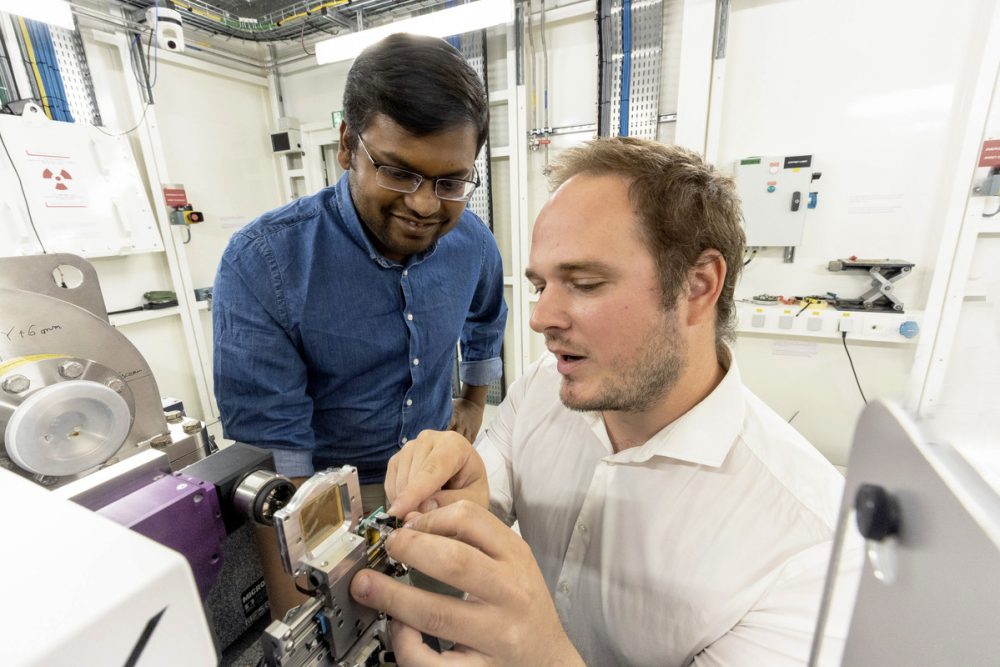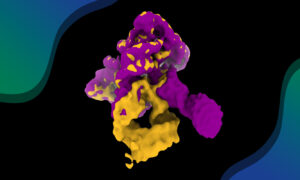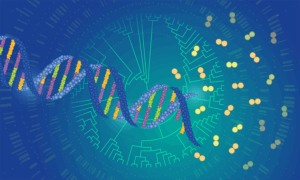
Teaming up to drive forward time-resolved crystallography
The recent construction of the new ID29 beamline in Grenoble is pioneering a new way of doing experiments in time-resolved crystallography and opening up technology transfer possibilities

Shibom Basu, beamline scientist in the McCarthy team, and Jeremy Sinoir, software developer and project leader in the Instrumentation team at EMBL Grenoble, put together their expertise to collaborate with the European Synchrotron Radiation Facility (ESRF) in building the new ID29 beamline at Grenoble to perform time-resolved serial crystallography (TR-SSX) experiments. In this interview, they share the impact of these technological advances, the main challenges they faced, and their motivation to take up this project.
Can you explain what time-resolved crystallography is and what it is used for?
Shibom Basu: In structural biology, researchers work on determining the 3D structure of biological molecules to understand their function. They also want to study the molecular motions involved in various biological processes, as well as how reactions are triggered and what happens as a result.
Experiments using time-resolved serial crystallography enable us to make molecular movies to visualise in 3D how a photo-activatable protein molecule — or an interaction with a photo-activatable compound triggering an enzymatic reaction — changes its conformation, or molecular dynamics when for example a drug binds to it. The ID29 beamline is equipped with a time-resolved setup to trigger a photochemical reaction in very small crystals (less than a micron in size), which allows it to take millions of snapshots with an X-ray beam during the course of the reactions. The compilation of these snapshots is then used to make a 3D molecular movie, like a stop-motion animation.
What does this new ID29 beamline achieve?
Shibom Basu: The Extremely Brilliant Source upgrade of the ESRF gave researchers the most brilliant source of X-rays in the world (105 – 106 times more flux density than any third generation synchrotron), allowing them to do new types of experiments. One of the flagship ideas to take advantage of this fourth generation synchrotron was to completely rebuild the ID29 beamline to do serial and time-resolved serial crystallography. But this came with the challenge of upgrading instruments to a higher level of precision and speed which, for time-resolved crystallography, was feasible only at free electron laser facilities, like the European XFEL, until now.
Jeremy Sinoir: The instrumentation team at EMBL Grenoble has been designing instruments for macromolecular crystallography and synchrotrons for decades. Daniele de Sanctis, the ESRF scientist in charge of the ID29 beamline, came to us four years ago with this idea for an upgrade, which would allow the ID29 beamline to study samples of less than a micron in size with a time resolution ranging from microseconds to milliseconds. We extensively discussed the idea within the team and with scientists at EMBL Hamburg, who are specialised in time-resolved crystallography.
Shibom Basu: We benefited from a very good synergy with the ESRF, as the project was made in the framework of the Joint Structural Biology Group between EMBL Grenoble and the ESRF. As a result of our work, ID29 is now bridging the gap between the third generation synchrotrons and the free electron laser facilities in terms of beam properties and capabilities of doing experiments in serial and time-resolved serial crystallography.
What kind of research will benefit from this new beamline?
Shibom Basu: This new beamline delivers a brighter, smaller, denser, and more coherent source of X-rays. Basically, this means that we can go faster and target smaller crystal sizes. This will push the boundaries of structural biology, rendering more detailed structural insights of physiologically important biological processes.
Such fundamental research will provide important insights for the development of solutions to new societal or environmental challenges, such as the design of new antimicrobials or biological sensors, as part of the Infection Biology and Planetary Biology transversal themes of EMBL’s new programme.
This will be particularly useful in photobiology to study proteins which are photo activable, like rhodopsin or plant-based proteins. This will also allow researchers to study how we can use sunlight for reactions and mimic it for alternative sources of energy. We can also do ‘photo cage experiments’ in drug design. This means putting a drug in a photoactivatable cage, opening the cage with the laser, and taking snapshots at different time points to trace the diffusion of the drug molecule toward the active site. By combining a series of snapshots, one can make a molecular movie which can be utilised in developing more efficient drugs.
What are the main challenges that you faced in this project?
Jeremy Sinoir: The motion synchronisation was definitely the most challenging part. To achieve microsecond time resolution in the time-resolved experiments, ID29 has been equipped with a beam chopper, which is a disk of metal with a hole in it, rotating very fast in front of the beam. It is aligned in such a way that the X-ray beam interacts with the sample only when the hole lets the beam pass through for a very restricted amount of time – about 10 microseconds in every one-millisecond period.
To make this work, we have to be sure that the sample is aligned in front of the beam exactly when the pre-aligned hole of the metal disk passes through, and that the detector is acquiring the frame (snapshot) at the exact same moment. As this process also involves two choppers, all of these four elements needed to be synchronised within a few microseconds and with a micrometer-range spatial precision — and we wanted to be able to do that one thousand times per second! We’ve been developing this for almost four years and now that it’s working, it’s amazing!
What are you planning to work on next?
Shibom Basu: We have been testing and debugging various components of the beamline over the summer and we received the first users around the end of September. We actually received a large amount of user proposals, just for this beamline!
Jeremy Sinoir: ID29 has the potential to become a source of innovation to develop new tools for chip loading and design. We came up with new ideas during the process to help with data collection and putting the sample in front of the beam in a more efficient way, and we will continue working on these.
On a more personal note, what motivated you to take up this project?
Jeremy Sinoir: When Daniele de Sanctis came to our team with this challenge, we had many ideas. The first three weeks were very intense for me, but also extremely rewarding, because Florent Cipriani (former Head of the Instrumentation team) gave me the opportunity to test my own solution and prove that it could be the right one. I was constantly thinking about it, even when at home. This project, and particularly these three weeks, have been crucial in my career.
Shibom Basu: My background is in serial crystallography but I wanted to switch to synchrotrons to address more biological questions. I was hired to do more serial-crystallography experiments, including this ID29 project. When I arrived here, it felt like heaven! Historically, the collaboration between EMBL and the ESRF has been at the forefront of innovative technology developments in macromolecular crystallography, and ID29 is one of the state-of-the-art beamlines. I’m learning every day, the instrumentation team is fantastic, and we have very lively exchanges with the ESRF scientists. It’s like in chemistry, when you mix things together, something new will come out. This is the power of multidisciplinarity.


